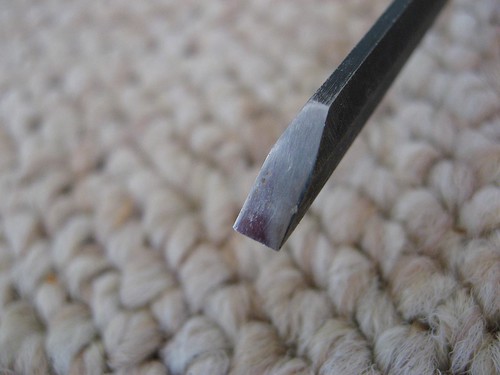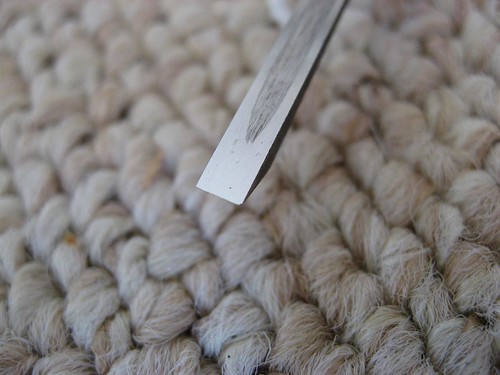Ask and ye shall receive.

This is what the front and back of the chisel looks like after chopping the cocobolo and the white oak. Still haven't resharpened it yet.


The "deterioration in the cutting edge" in the photo you pointed out is really wood dust that caused a weird reflection. You can see that the vast majority of the edge is clean, and the only thing I can see is a tiny chip in the corner. It may appear that there is a small chip about a quarter of the way over in the second picture, but that's really a weird reflection. (It's amazing how hard it is to photograph a chisel edge.)
To the naked eye, it's really hard to see this chip on the chisel.
Chip/edge breakdown issues aside, the point remains that I can get clean endgrain shavings in pine with this chisel after chopping multiple times through two inches of cocobolo and 8/4 white oak.
To everyone in this thread:
The reason I decided to try this out is because on this and other woodworking fora I keep reading statements like the following:
- "If you were to try to use a japanese chisel to chop a dovetail on cocobolo, you'd be up $#!+ creek after the first mallet blow. (much less lignum vitae)"
- "You have to be careful with Japanese chisels compared to western chisels or the edge will chip, which then requires more major sharpening."
- "I'd recommend the older western chisels and the LN chisels before I'd recommend spending the large sums required for name brand Japanese chisels."
- "I don't think [Japanese chisels are] the best for a beginning woodworker because I think they're not as tolerant of mistakes as western chisels (it's easier to damage the edge)."
I'm not trying to single anyone out, which is why I anonymized the quotes. But I think that there is a great deal of misinformation about Japanese tools and their capabilities.
It is a misperception that Japanese tools are only useful for softwoods. Much woodworking in Japan was done with softwoods. But a significant amount of woodworking was done in hardwood as well. Case in point: the bodies of Japanese planes are almost exclusively made of Japanese white oak. The same chisels were used to chop out the opening of these wooden plane bodies as were used on softwoods. A search of antique Japanese furniture will turn up pieces made with keyaki (zelkova), and chestnut (kuri), both of which are hardwoods.
It is also a misperception that Japanese chisels are prone to chipping. This statement is no more true than saying, "Western chisels roll their edge all the time." Once you get into an adequate level of quality in Japanese chisels, the chipping issue goes away. And no, I don't count the Grizzly or Woodcraft Japanese chisel sets as an adequate level of quality for Japanese chisels, any more than I would consider Grizzly or Woodcraft house brand western chisels as an adequate representation of quality for western chisels. Hopefully this demo puts that issue to rest.
It is also a misperception that quality Japanese tools have to be super expensive. The Imai chisels that I use, at $50-55 each in the 1" or less sizes, are definitely competitive in price to Lie-Nielsen bevel edge socket chisels, which are $50 each except for the 1" size which is $65. (1" is the largest LN chisel available.) The set of 5 LN bevel edge socket chisels (1/8, 1/4, 3/8, 1/2, 3/4") goes for $250. A set of 5 Imai chisels in the same sizes is $258.30. There are more expensive Japanese chisels out there, but you don't need them to get good performance.
I do think that Japanese chisels are good for the beginner. If it's okay to recommend LN chisels for a beginner, it's also okay to recommend Imai chisels for the beginner, since the cost is the same. The big advantages that I see with Japanese chisels (specifically my Imai chisels) are:
- You don't have to learn how to sharpen a microbevel to get excellent results, which means that you can stop relying on jigs for sharpening.
- The relatively larger bevel area on a Japanese chisel compared to western chisels also makes freehand sharpening easier than with western chisels.
- Although the Japanese steels used in the cutting layer are very hard, with waterstones they are as easy or easier to sharpen than the A2 chisels I've run across, including the Lie-Nielsens.
- I haven't found the western chisel yet that has the same edge edurance that I have with my Imai chisels.
Finally, I don't understand the issue of using my Imai chisels as a test subject, in the "Well, of course this chisel did so well -- it's an Imai chisel, after all!" sense. This chisel costs $49.20 today, same as a Lie-Nielsen 1/8" bench chisel. In addition, this chisel is actually middle of the road as far as Japanese chisels go. It's not like I used a super high end chisel for this demo.
I don't get the sense that if the situation was reversed, and I had used a Lie-Nielsen chisel to test the proposition that western chisels can't deal with cocobolo because the edge would get rolled after one mallet blow, anyone would think that it wasn't an appropriate test because I used a Lie-Nielsen instead of a Grizzly house brand chisel.
In any case, this test was fun for me, and I hope that it settles some of the misperceptions about Japanese chisels.












 Reply With Quote
Reply With Quote